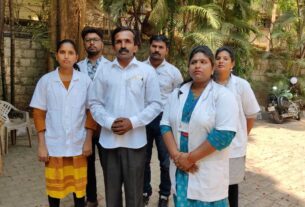Swachh Bharat Mission Gramin (SBMG) claims that they have constructed IHHL (Individual Household Laterines) with 100 percent coverage in Urban Benagluru.
Bengaluru: K Gollahalli Village, Kengeri Hoballi still faces a shortage of household toilets despite the Swachh Bharat Mission Gramin (SBMG) claim that they constructed IHHL with 100 percent coverage in Urban Bengaluru.
Ranga, 32, said that all four members of his family have to defecate near a lake by the village.
He further said, “I asked five to 10 times for subsidy from gram panchayat but they said they don’t have any scheme for building toilets.”
Raghu, 38, said that the gram panchayat refused to give him subsidy for building toilets at his house so his whole family has to defecate in fields.
Women face more difficulties than men due to lack of toilets. Meghna R, 23, said whenever she menstruates, she has to use her neighbour’s toilet because she does not have one at her house.
According to the SBMG website, by 2018-19, 69,06,099 Individual Household Latrines (IHHLs) were constructed across the Karnataka state with 100 percent coverage in both rural and urban Bengaluru.
SBMG was implemented on Oct. 2, 2014. Phase 1 of SBMG prevailed from 2014 to 2020. According to this scheme, every household, school and anganwadi should have a toilet and it should be accessible.
Under this scheme, every Below Poverty Line (BPL) households, Scheduled Castes (SC) and Scheduled Tribes (ST) households belonging to restricted Above Poverty Line (APL) sector, small and micro families, landless families, differently-abled families and households headed by women can construct individual toilets with a subsidy of Rs.12,000.
Denying all the allegations, Ravi Kumar, Tax-collector, K Gollahalli Gram Panchayat said that the Swacch Bharat Mission prevailed from 2015 to 2019 in the village and toilets were constructed throughout the village; therefore, every house in the village has a toilet.
He said that by 2019, the village was declared open defecation free (ODF).
Under SBMG, by Oct. 2 2019 India declared itself “open-defecation free” (ODF) by constructing over 100 million toilets in rural India.
Somalinga, Panchayat Development Office, K Gollahalli Gram Panchayat said that all houses in the village have toilets and he hasn’t received any request for subsidy for building household toilets.
Additionally, residents of K Gollahalli who have toilets at their houses said the toilets lack maintenance. Meghna, 25, said that she has a toilet at her house but there is no water connection in it.
Shanta, 60, said that she did not receive any subsidy from gram panchayat for building a toilet so she built one with her own money.
Dr. Chandrashekhar Kottagi, Masters in Public Health (MPH), Team Leader of Institute in Public Health (IPH), an NGO explained that in every village, gram panchayat has to form a Village Health Sanitization and Nutrition Committee (VHSNC), chaired by the President of Gram Panchayat. The committee gives subsidies to people and help them in building toilets in order to make their village open defecation-free. They also have to ensure that the toilets are properly functioning and have enough water supply, he added.
He added that lack of toilets leads to open defecation which causes contamination of food and water leading to the spread of diseases such as diarrhoea, cholera and dysentery. In rural areas, diarrhoea and dysentery are the major causes of deaths in children under the age of five, he added.
Dr. Shon Mathew R, MBBS, Associate Consultant, Community Health and Research, Baptist Hospital, Vinayakanagar said that women suffer the most due lack of toilets as using community toilets can lead to Urinary Tract Infection (UTI) and other genital infectious diseases such as vaginal candidiasis, bacterial vaginitis, etc.




